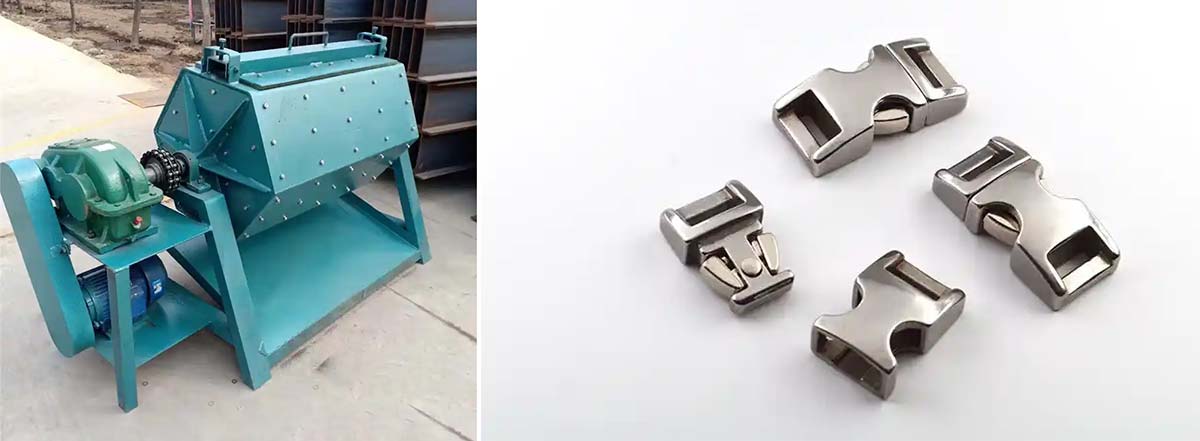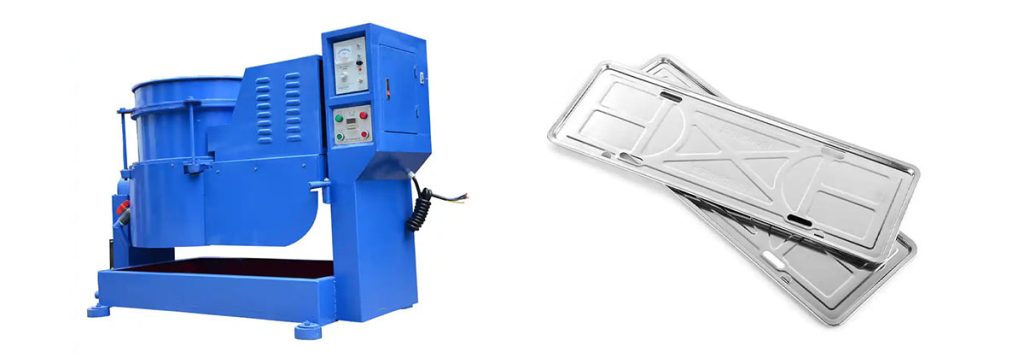

Aerospace manufacturing demands exceptional precision and quality to ensure safety and performance. The use of a metal buffer polisher plays a critical role in achieving these standards by delivering smooth, defect-free surfaces on metal components. The global polishers market continues to grow, driven by the aerospace sector’s need for high-precision polishing. Manufacturers increasingly rely on advanced equipment, including metal buffer polisher, to meet stringent industry requirements.
Technological advancements in buffing machinery, such as metal buffer polisher, is transforming the industry. Automation and IoT integration enhance efficiency and enable real-time monitoring, while eco-friendly solutions address sustainability concerns. These innovations ensure that aerospace components meet exacting specifications, supporting the industry’s commitment to excellence.
Key Takeaways
- Use better metal polishers to improve accuracy and speed in aerospace work.
- Pick machines with smart tech and automation to save time and money.
- Make sure the polisher works with different aerospace materials for good results.
- Choose strong machines with good support to avoid delays and last longer.
- Get eco-friendly polishers to help the planet and work efficiently.
Key Features to Look for in 2025
Advancements in Technology
AI Integration in Buffing Machinery
Artificial intelligence has revolutionized buffing machinery by automating complex processes. AI-powered systems analyze real-time data to optimize polishing operations, ensuring consistent results. These systems enhance efficiency by increasing production speed and reducing human intervention. They also improve precision, which is critical for aerospace components requiring flawless surface finishing. AI integration minimizes waste and energy consumption, making operations more sustainable. Buffing machinery manufacturers now focus on incorporating AI to meet the growing demand for high-quality polishing machines.
Automation Capabilities in Metal Polishing Equipment
Automation in metal polishing equipment has significantly boosted productivity and performance. Automatic buffing machines streamline operations by handling repetitive tasks with unmatched accuracy. These machines reduce labor costs while maintaining high-quality standards. Advanced technology enables automated systems to adapt to different types of metal polishing equipment, ensuring compatibility with various aerospace materials. Automation also enhances production efficiency, allowing manufacturers to meet tight deadlines without compromising quality.
Materials Compatibility for Aerospace Applications
Aerospace components often involve diverse materials, including aluminum, titanium, and composites. Metal polishing equipment must accommodate these materials without compromising performance. Buffing machinery products designed for aerospace applications ensure compatibility with both soft and hard metals. This versatility allows manufacturers to achieve uniform surface finishing across different components. Buffing machine suppliers prioritize developing solutions that cater to the unique needs of aerospace materials, ensuring durability and precision.
Durability and Longevity of Metal Buffer Polishers
Durability is a key factor when selecting a metal buffer polisher for aerospace applications. Polishing machines must withstand rigorous use while maintaining consistent performance. High-quality materials and robust construction ensure the longevity of these machines. Buffing machinery manufacturers emphasize durability to reduce maintenance costs and downtime. Investing in durable equipment enhances productivity and ensures reliable surface finishing solutions over time.
Eco-Friendly Features in Automatic Buffing Machines
Sustainability has become a priority in aerospace manufacturing. Manufacturers now design automatic buffing machines with eco-friendly features to reduce environmental impact. These innovations align with the industry’s commitment to greener practices while maintaining high performance.
Energy efficiency is one of the most notable advancements. Many modern machines consume less power without compromising output. This improvement lowers operational costs and reduces carbon emissions. Some models incorporate energy-saving modes, which optimize power usage during idle periods.
Water conservation is another critical feature. Traditional polishing processes often require significant water usage. Newer machines recycle water through advanced filtration systems, minimizing waste. This approach not only conserves resources but also reduces the cost of water disposal.
Eco-friendly materials play a role in the construction of these machines. Manufacturers use recyclable or biodegradable components wherever possible. This choice ensures that the equipment has a reduced environmental footprint throughout its lifecycle.
Emission control systems have also improved. Automatic buffing machines now include advanced filters to capture dust and particles generated during polishing. These systems prevent harmful substances from entering the atmosphere, promoting cleaner air quality in manufacturing facilities.
Some machines integrate smart technology to monitor environmental performance. Sensors track energy and resource usage, providing real-time data to operators. This information helps manufacturers identify areas for further improvement, ensuring sustainable practices remain a focus.
By incorporating these eco-friendly features, the latest automatic buffing machines support both environmental goals and operational efficiency. They represent a step forward in creating a more sustainable aerospace industry.
Top Metal Buffer Polishers for Aerospace Components in 2025
Machine 1: OTEC CF Series
Manufacturer: OTEC
The OTEC CF Series stands out as a compact and high-precision solution for polishing small aerospace components. Its advanced centrifugal technology ensures consistent and superior finishes, making it a preferred choice for manufacturers seeking reliable surface finishing solutions.
| Metric | Value |
|---|---|
| Surface Roughness | Ra 0.01 µm |
| Process Speed | Up to 24 times faster than conventional methods |
| Engine Friction Reduction | Significant due to ultra-smooth surfaces |
| Customization | Tailored systems for specific requirements |
| Efficiency Improvement | Boosts gearbox efficiency by minimizing friction |
The OTEC CF Series delivers unmatched performance by reducing surface roughness to an impressive Ra 0.01 µm. Its high-speed polishing capabilities improve production speed and efficiency, making it ideal for aerospace applications. Additionally, its ability to enhance gearbox efficiency through friction reduction highlights its role in improving overall performance.
Machine 2: Acme Robotic Polishing System
Manufacturer: Acme Aerospace

The Acme Robotic Polishing System combines advanced technology with automation to deliver high-quality finishes for aerospace components. Designed specifically for the aerospace and power generation industries, this system offers several unique advantages:
- Enhanced finishing quality and consistency.
- Increased productivity through robotic automation.
- Significant cost reductions by lowering unit costs.
- Automation of traditionally manual processes, improving safety.
- Seamless integration with user-friendly HMI for operator ease.
| Feature | Description |
|---|---|
| Seamless integration | User-friendly interface for quick system integration, facilitating operator ease of use. |
| Consistency and quality | Uses a golden part reference to ensure accurate specifications despite part wear. |
| Increased productivity | Robotic Auto Path Generation enhances productivity and reduces unit costs in aerospace MRO. |
| Swift robot path generation | Advanced 3D scanning technology automates part-specific path generation, minimizing manual work. |
| Precision enhancement | Software creates precise paths for consistent surface finishes, meeting strict aerospace tolerances. |
This system excels in production efficiency by automating complex polishing tasks. Its ability to generate precise robotic paths ensures consistent results, even for intricate aerospace components. With a high ROI, it represents a valuable investment for manufacturers aiming to optimize productivity and performance.
Machine 3: Mass Finishing MFI Series
Manufacturer: Mass Finishing, Inc.
The Mass Finishing MFI Series offers versatile polishing capabilities, making it suitable for intricate aerospace parts. This machine effectively polishes a wide range of metals, including:
- Heat-treated steel
- Aluminum
- Stainless steel
- Tool steel
- Hardened steel
- Carbon steel
Its design focuses on reaching hard-to-access areas, ensuring uniform surface finishing across complex geometries. The MFI Series delivers high-quality finishes while maintaining efficiency, making it a reliable choice for aerospace manufacturers. Its ability to handle diverse materials highlights its adaptability and performance in demanding applications.
How to Choose the Right Polisher?
Assessing Production Needs for Buffing Machinery
Understanding production needs is essential when selecting buffing machinery. Manufacturers must evaluate the scale of their operations and the complexity of the components they produce. High-volume production facilities benefit from polishing machines with automation features that enhance productivity and reduce manual labor. For smaller operations, compact and versatile machines may provide better value.
Production speed plays a critical role in meeting deadlines. Machines designed for aerospace applications often prioritize efficiency without compromising quality. Buffing machinery manufacturers offer solutions tailored to specific production requirements, ensuring consistent performance across various tasks. By aligning machine capabilities with production goals, manufacturers can optimize productivity and maintain high standards.
Evaluating Material Compatibility of Metal Polishing Equipment
Material compatibility is a key factor in choosing the right metal polishing equipment. Aerospace components often involve diverse materials, each requiring specific abrasives and techniques. Selecting equipment that accommodates these variations ensures consistent results and prevents damage to components.
The following table highlights important considerations for evaluating material compatibility:
| Consideration | Description |
|---|---|
| Understanding Material Properties | Different materials require specific abrasives; hard materials need harder abrasives, while softer materials need gentler ones. |
| Desired Finish | The required surface quality influences the choice of polishing powder; finer abrasives yield a mirror-like finish. |
| Cost-Effectiveness | Balancing cost and performance is crucial; high-end abrasives provide excellent results but at a higher price. |
| Environmental and Health Considerations | Safety and environmental impact must be considered; some powders pose health risks, necessitating protective measures. |
Buffing machinery manufacturers design equipment to handle a wide range of materials, ensuring versatility and reliability. Machines capable of delivering a mirror finish on intricate components enhance both functionality and aesthetics.
Considering Cost and Budget for Automatic Buffing Machines
Cost and budget considerations play a significant role in the decision-making process. While high-end polishing machines often feature advanced technology and superior performance, they may exceed the budget of smaller manufacturers. Evaluating the total cost of ownership, including maintenance and energy consumption, helps determine long-term value.
Automatic buffing machines with energy-efficient designs reduce operational costs while maintaining high productivity. Investing in durable equipment minimizes downtime and repair expenses, further enhancing production efficiency. Manufacturers should prioritize machines that balance affordability with performance, ensuring they meet both financial and operational goals.
By carefully assessing production needs, material compatibility, and budget constraints, manufacturers can select the ideal metal buffer polisher for their aerospace applications.
Maintenance and Support Requirements for Long-Term Quality

Proper maintenance ensures the long-term quality and performance of a metal buffer polisher. Neglecting upkeep can lead to inefficiencies, increased downtime, and costly repairs. Manufacturers must adopt a structured approach to maintain their equipment and achieve consistent results.
A well-planned maintenance schedule is essential. Operators should follow the manufacturer’s recommendations to perform regular checks. Lubrication is a critical step in reducing friction and wear on moving parts. Applying the correct lubricant at specified intervals prevents damage and extends the machine’s lifespan. Inspecting components like belts, brushes, and polishing pads for wear ensures the equipment operates at peak efficiency.
Electrical components require close monitoring. Frayed cables or loose connections can disrupt operations and pose safety risks. Regular inspections help identify and resolve these issues before they escalate. Calibration and alignment are equally important. Misaligned parts can cause uneven polishing, reducing the quality of the finished product.
Temperature control plays a vital role in maintaining efficiency. Overheating can damage internal components, so adequate cooling or ventilation is necessary. Storing the machine in a clean, dry environment prevents rust and other forms of corrosion. Training operators on proper usage and maintenance practices enhances the machine’s performance and reduces the likelihood of errors.
Professional servicing adds another layer of reliability. Scheduling periodic check-ups with qualified technicians ensures that the machine remains in optimal condition. These experts can identify potential problems early and recommend solutions. Preventative maintenance, combined with proper storage and operator training, maximizes the machine’s efficiency and longevity.
By prioritizing maintenance and support, manufacturers can reduce downtime, improve productivity, and maintain high-quality finishes. A well-maintained metal buffer polisher not only enhances efficiency but also ensures consistent results for aerospace applications.
Conclusion
Selecting the right metal buffer polisher ensures aerospace components meet the highest standards of quality. Advanced features in buffing machinery, such as automation and AI integration, enhance production efficiency and deliver unmatched precision. These innovations help manufacturers achieve consistent results while reducing operational costs.
Investing in high-quality buffing machinery offers long-term benefits. Durable equipment minimizes downtime and ensures reliable performance. Manufacturers can improve productivity and maintain superior quality by choosing machines tailored to their specific needs. The latest advancements in buffing machinery represent a significant step forward for the aerospace industry.
